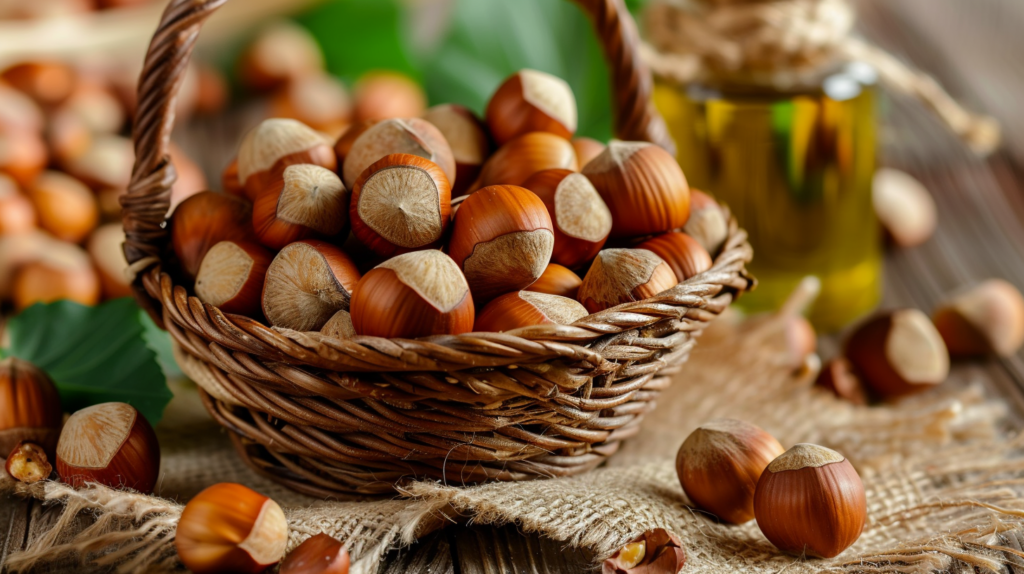Why Is the Turkish Tombul Hazelnut So Popular?
The Turkish Tombul hazelnut stands out in the global market due to its exceptional qualities and Turkey’s dominant position in the hazelnut industry. This article delves into the reasons behind the popularity of the Tombul hazelnut, focusing on its nutritional value, flavor, and the factors contributing to its cultivation and production.
Nutritional Value
The Turkish Tombul hazelnut is renowned for its high nutritional value. It is an excellent source of vitamin E, providing 24 mg per 100 grams, which plays a crucial role in protecting cells from oxidative stress and supporting immune function (Alasalvar et al., 2003). Additionally, Tombul hazelnuts are rich in B vitamins, which are essential for energy metabolism and maintaining healthy skin and muscles (Alasalvar et al., 2003; Çalışır et al., 2005).
Dietary fiber is another significant component of Tombul hazelnuts, aiding in digestion and contributing to cardiovascular health. The nuts are also abundant in essential minerals, including potassium, phosphorus, calcium, magnesium, and selenium (Alasalvar et al., 2003; Özgün et al., 2006). These minerals are vital for various bodily functions, such as bone health, muscle function, and the maintenance of a healthy immune system.
Fat is the predominant component of Tombul hazelnuts, comprising approximately 61% of their composition (Alasalvar et al., 2003; Özgün et al., 2006). The fats found in hazelnuts are mostly monounsaturated and polyunsaturated fats, which are beneficial for heart health. These healthy fats help in reducing bad cholesterol levels (LDL) and increasing good cholesterol levels (HDL), thus lowering the risk of heart disease (Alasalvar et al., 2003).
Flavor
The flavor profile of Tombul hazelnuts significantly contributes to their popularity. These nuts have a pleasant and desirable flavor, characterized by high levels of taste-active components such as free amino acids, sugars, and organic acids (Köksal et al., 2006). Arginine, the most abundant amino acid in Tombul hazelnuts, is known for its role in protein synthesis and as a precursor for the synthesis of nitric oxide, which is vital for vascular health (Alasalvar et al., 2003).

Sucrose is the predominant sugar in Tombul hazelnuts, contributing to their sweet taste. This sweetness is balanced by the presence of organic acids, with malic acid being the major one, which adds a slight tartness to the flavor profile (Alasalvar et al., 2003). This unique combination of sweet and slightly tart flavors makes Tombul hazelnuts particularly appealing for various culinary uses, from snacking to incorporation in confectionery and baked goods.
Cultivation and Production
Turkey holds the title of the world’s largest producer and processor of hazelnuts, and the Tombul variety is one of the major traditional cultivars grown, especially in the Black Sea region (Hazelnut production in Turkey, n.d.). The favorable climate and soil conditions in this region provide an ideal environment for hazelnut cultivation. The hazelnut industry in Turkey involves around 400,000 families, indicating its significant socio-economic impact (Hazelnut production in Turkey, n.d.).
The Turkish government has supported the hazelnut industry through various policies, such as the 1964 Guarantee of Purchase law, which has helped stabilize and increase production (Hazelnut production in Turkey, n.d.). This consistent and reliable supply has enabled Turkey to dominate the global hazelnut market, exporting to over 100 countries. The high production volume and quality of Turkish hazelnuts have contributed to the international popularity of the Tombul variety.
The Tombul hazelnut’s popularity is also driven by Turkey’s extensive processing capabilities. The country has developed advanced processing techniques that enhance the quality and shelf-life of hazelnuts, making them more attractive to international buyers (Köksal et al., 2006). These processing methods ensure that the nuts retain their nutritional value and flavor, further solidifying their reputation in the global market.
Economic Benefits
The economic impact of the Tombul hazelnut is profound. The hazelnut industry in Turkey generates significant revenue, contributing to the livelihoods of many families involved in its cultivation and processing. The popularity of Tombul hazelnuts in international markets has led to increased export revenues, supporting the national economy.
Moreover, the demand for Tombul hazelnuts has stimulated growth in related industries, such as packaging, transportation, and marketing. This ripple effect creates job opportunities and drives economic development in regions where hazelnut cultivation is prevalent.
Market Dynamics
The global demand for hazelnuts, particularly the Tombul variety, continues to grow due to their versatile applications in the food industry. Hazelnuts are a key ingredient in many popular products, including spreads like Nutella, chocolates, pastries, and health bars. The rising consumer interest in healthy snacking options has further boosted the demand for hazelnuts, given their rich nutritional profile.
In addition to their use in traditional products, there is a growing trend towards incorporating hazelnuts into innovative food items. This trend is driven by the increasing awareness of the health benefits of nuts and the desire for unique and flavorful ingredients. As a result, the Tombul hazelnut has found its way into new and diverse culinary applications, enhancing its popularity.
Conclusion
The Turkish Tombul hazelnut has earned its popularity through a combination of exceptional nutritional value, appealing flavor, and Turkey’s dominant position as the leading producer and exporter of hazelnuts. The high levels of vitamins, minerals, and healthy fats in Tombul hazelnuts make them a nutritious choice, while their unique flavor profile adds to their desirability. Turkey’s favorable growing conditions, advanced processing techniques, and supportive government policies have ensured a consistent and high-quality supply of these nuts to the global market.
The economic benefits of the Tombul hazelnut are significant, contributing to the livelihoods of many families and supporting various industries. The growing global demand for hazelnuts, driven by their versatile applications and health benefits, indicates that the popularity of the Turkish Tombul hazelnut is likely to continue rising. As consumers increasingly seek nutritious and flavorful ingredients, the Tombul hazelnut remains a top choice in the international market.
References
Alasalvar, C., Shahidi, F., Liyanapathirana, C. M., & Ohshima, T. (2003). Turkish Tombul Hazelnut (Corylus avellana L.) 1. Compositional Characteristics. Journal of Agricultural and Food Chemistry, 51(13), 3790-3796. https://pubmed.ncbi.nlm.nih.gov/12797745/
Çalışır, S., Marakoğlu, T., & Öğüt, H. (2005). Physical properties of Turkish hazelnut varieties. Journal of Food Engineering, 68(2), 133-138. https://www.sciencedirect.com/science/article/abs/pii/S0308814620301928
Hazelnut production in Turkey. (n.d.). In Wikipedia. Retrieved from https://en.wikipedia.org/wiki/Hazelnut_production_in_Turkey
Köksal, A. I., Artik, N., Güneş, N., & Şimşek, A. (2006). Nutrient composition of hazelnut (Corylus avellana L.) varieties cultivated in Turkey. Food Chemistry, 99(3), 509-515. https://www.researchgate.net/publication/7026760_Turkish_Tombul_Hazelnut_Corylus_avellana_L_1_Compositional_Characteristics
Özgün, E. K., & Özdemir, M. (2006). A research on the fatty acid composition of Turkish hazelnut oil. Journal of Food Science, 71(4), S160-S165. https://pubs.acs.org/doi/abs/10.1021/jf0212385?src=recsys






